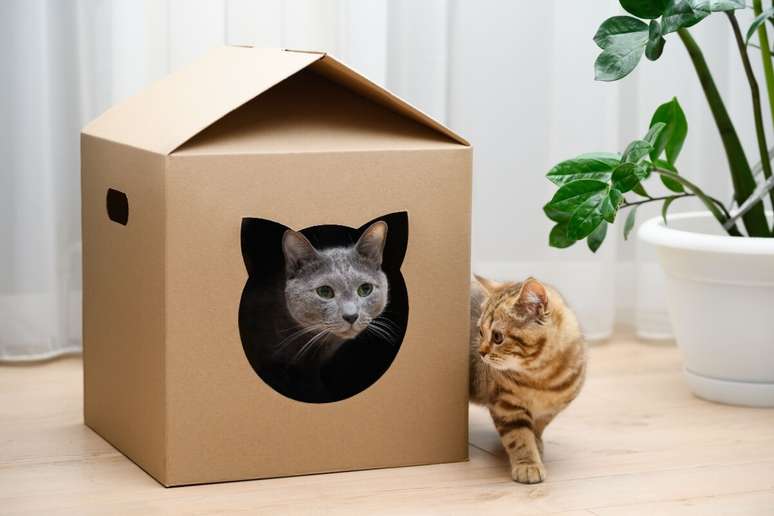See how to carry out the transition to the new quieter and safer home for your pet
Cats are extremely territorial animals and attached to the environment in which they live. They build their safety from the smells, sounds and the will of the objects that surround them. Any change in this scenario can lead to unease and insecurity, making adaptation to a new home a great challenge. This is because, in the face of an unknown space, the feline loses the points of reference, making it feel threatened and be in alert.
This stress can influence not only cat’s behavior, but also your health. During this transition period, changes in appetite, apathy, excessive vocalizations, aggression and even digestive problems can arise. In addition, the immune system can be compromised, making the animal more sensitive to diseases. To avoid these problems and guarantee a more silent adaptation, it is important to adopt some specific treatments after moving home. Subsequently, take a look at some suggestions!
1. Prepare the new home before the cat arrival
Before taking the cat For the new home, make sure the environment is safe and suitable for receiving it. If there are windows or balconies, install protective networks to avoid falls. Make sure there are small spaces in which the cat can hide and get stuck, such as behind heavy furniture or appliances. Also, make sure there are no chemicals or exposed threads that can be dangerous.
2. Book a quiet room for the initial adaptation
Upon arrival at the new house, do not immediately leave the cat throughout the environment. This can generate insecurity and fear. Instead, choose a quieter room, where it can gradually familiarize yourself – and to your rhythm – with new smells and sounds.
Put objects that already belonged to it, such as walking, covered, toys, sandbox, scratches and nutrition in this space. The presence of these objects, which has the old smell, helps to transmit a sense of continuity and safety.
3. Gradually presents the rest of the house
After a while in the initial room, it begins to allow the cat to gradually explore the rest of the house. Leave the doors open and let it go comfortablealways supervising. It is possible to facilitate the process by spreading family objects at home, such as covers and toys, so that it has a family smell in different rooms and recognizes the new environment as sure.
4. Respect the cat’s time
Each cat has its own rhythm to get used to new situations. Some could explore the house in a few hours, while others take days or even weeks to feel safe. Do not force the interactions and respect the space from him. If you want to hide, allow it. Staying behind furniture or internal boxes can be a way to face fear. Trust will be built gradually and the patience of the tutor is essential in this process.

5. Keep the food routine
Cats are extremely sensitive to routine changes e food It is one of the most important aspects to maintain emotional stability. It continues to offer the same ration and in the same times in which it was used to. Sudden dietary changes can cause digestive discomfort and increase stress. In addition, access to fresh water should be constant to ensure the hydration of the animal.
6. Use synthetic pheromones to reduce stress
The synthetic pheromones imitate the natural chemical signs that cats produce to mark the territory and feel safe. These products can be found in the form of electrical speakers or spray and help to calm the cat, reducing anxiety and facilitating adaptation.
The ideal is to start using them a few days before the change, both in the old and new home, to create a more welcoming environment. Talk to a veterinarian for a guide on the correct use of this function.
7. Offer a enriched environment
Environmental enrichment is essential to keep the cat mentally stimulated and help him feel more comfortable. Provide scratches, high shelves, boxes, lairs and toys interactive so that you can explore and distract yourself.
In addition, book a quiet space for moments of rest, far from intense noises and movements. A well -structured environment helps to reduce boredom and anxiety, making adaptation more relaxed.
8. Avoid high noises and excessive movements
In the first days following change, try to keep the house more smooth possible. Avoid renovation, changes in decoration or receive many visits during this period. High sounds such as music, television at maximum volume or appliances can frighten the cat and make it difficult to adapt. A calm environment allows you to explore the new territory in a safer way, without associating it with negative experiences.

9. Provide safe hiding places
Cats like to have places where they can hide every time they feel necessary. Leave cardboard boxesWalks covered or even high shelves available is a great way to provide safety. These spaces serve as a refuge when the feline needs a moment of tranquility.
10. Observe cat health and behavior
During the adaptation period, be aware of the changes in the behavior and health of cats. The loss of appetite, vomiting, diarrhea, excess licking, frequent vocalizations or aggression can be signs of high stress. If these symptoms persist for more than a few days, it is important to consult a veterinarian to evaluate the health of the animal. The professional follow-up can ensure that the adaptation occurs without compromising the well-being of the feline.
Source: Terra
Ben Stock is a lifestyle journalist and author at Gossipify. He writes about topics such as health, wellness, travel, food and home decor. He provides practical advice and inspiration to improve well-being, keeps readers up to date with latest lifestyle news and trends, known for his engaging writing style, in-depth analysis and unique perspectives.








